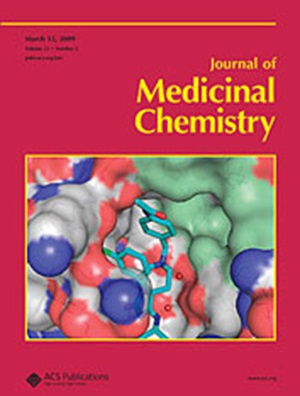New Insights into the French Paradox: Free Radical Scavenging by Resveratrol Yields Cardiovascular Protective Metabolites.
IF 6.8
1区 医学
Q1 CHEMISTRY, MEDICINAL
引用次数: 0
Abstract
Resveratrol was subjected to a diversity-oriented synthesis using oxidative transformations by various biorelevant, biomimetic, or biomimetic-related chemical reagents. Using a combined strategy of ultrahigh-resolution profiling, bioactivity screening, and bioactivity-guided isolation, 19 metabolites were obtained. The compounds were tested for their in vitro enzyme inhibitory activity on angiotensin-1 converting enzyme (ACE), cyclooxygenase-1 and -2, and 15-lipoxygenase (LOX), and evaluated for their relevant drug-like properties in silico. The compounds demonstrated a generally increased cardiovascular protective and anti-inflammatory potential and better drug-likeness compared to resveratrol. Trans-δ-viniferin (6) was identified as a competitive, C-domain-selective ACE inhibitor that is over 20 times more potent than resveratrol. Further, trans-ε-viniferin (2) acted as an over 40 times stronger LOX inhibitor than resveratrol. While our results cannot be directly translated to the health benefits of dietary resveratrol consumption without further studies, it is demonstrated that biologically relevant oxidative environments transform resveratrol into potent cardiovascular protective and anti-inflammatory metabolites.对法国悖论的新见解:白藜芦醇清除自由基产生心血管保护代谢产物。
白藜芦醇是通过各种生物相关的、仿生的或与仿生相关的化学试剂进行氧化转化的,以多样性为导向的合成。采用超高分辨率谱分析、生物活性筛选和生物活性引导分离相结合的策略,获得了19种代谢物。测定了化合物对血管紧张素-1转换酶(ACE)、环氧化酶-1和-2、15-脂氧化酶(LOX)的体外酶抑制活性,并评价了它们的相关药物性质。与白藜芦醇相比,这些化合物显示出普遍增加的心血管保护和抗炎潜力以及更好的药物相似性。反式-δ- vinifin(6)是一种竞争性的c -domain选择性ACE抑制剂,其效力是白藜芦醇的20倍以上。此外,trans-ε- vinifin(2)作为LOX抑制剂的作用比白藜芦醇强40倍以上。虽然在没有进一步研究的情况下,我们的结果不能直接转化为饮食中摄入白藜芦醇的健康益处,但已经证明,生物相关的氧化环境将白藜芦醇转化为有效的心血管保护和抗炎代谢物。
本文章由计算机程序翻译,如有差异,请以英文原文为准。
求助全文
约1分钟内获得全文
求助全文
来源期刊

Journal of Medicinal Chemistry
医学-医药化学
CiteScore
4.00
自引率
11.00%
发文量
804
审稿时长
1.9 months
期刊介绍:
The Journal of Medicinal Chemistry is a prestigious biweekly peer-reviewed publication that focuses on the multifaceted field of medicinal chemistry. Since its inception in 1959 as the Journal of Medicinal and Pharmaceutical Chemistry, it has evolved to become a cornerstone in the dissemination of research findings related to the design, synthesis, and development of therapeutic agents.
The Journal of Medicinal Chemistry is recognized for its significant impact in the scientific community, as evidenced by its 2022 impact factor of 7.3. This metric reflects the journal's influence and the importance of its content in shaping the future of drug discovery and development. The journal serves as a vital resource for chemists, pharmacologists, and other researchers interested in the molecular mechanisms of drug action and the optimization of therapeutic compounds.
 求助内容:
求助内容: 应助结果提醒方式:
应助结果提醒方式:


